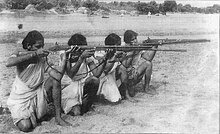
Back تمرد تيلانغانا Arabic Révolte du Telangana French तेलंगाना विद्रोह Hindi Pemberontakan Telangana ID Rivolta telangana Italian തെലുങ്കാന സമരം Malayalam Telanganaopprøret NB د تلنګانه بغاوت Pashto/Pushto தெலுங்கானா மக்களின் ஆயுதப் போராட்டம் (1946-1951) Tamil తెలంగాణ విమోచనోద్యమం Tegulu
| Telangana Rebellion Telangana Sayudha Poratam | |||||||
|---|---|---|---|---|---|---|---|
| Part of the Indian independence movement | |||||||
 Women rebels of the Telangana Rebellion | |||||||
| |||||||
| Belligerents | |||||||
|
Supported by: |
1946–1948:
1948–1950:
1950–1951: Supported by: | ||||||
| Commanders and leaders | |||||||
| Localised leadership |
| ||||||
| Units involved | |||||||
| -- |
| ||||||
The Telangana Rebellion, natively known as Telangana Sayudha Poratam,[a] was a communist-led[1] insurrection of peasants against the princely state of Hyderabad in the region of Telangana, Dominion of India, that escalated out of agitations in 1944–46.[2]
Hyderabad was a feudal monarchy where most of the land was concentrated in the hands of landed aristocrats known as durras in Telangana. Feudal exploitation in the region was more severe compared to others of India; the durras had complete power over the peasants and could subject them to agricultural slavery. Conditions worsened during the 1930s due to the Great Depression and a transition towards commercial crops. In the 1940s, the peasants started turning towards communism, organised themselves through the Andhra Mahasabha and began a rights movement, catalyzed by a food crisis that affected the region following the end of the Second World War, the movement escalated into a rebellion after the administration and the durras attempted to suppress it.
The revolt began on 4 July 1946, when a local peasant leader was killed in the village of Kadavendi, Warangal district, by the agents of a durra. Beginning in the districts of Nalgonda and Warangal, the rebellion evolved into a revolution across Telangana in response to continued repression by the Nizam Mir Osman Ali Khan and later Kasim Razvi. The Hyderabad State Forces and the police, combined with the Razakar militia, were unable to suppress it and were routed, while the rebel forces went on a successful guerrilla offensive.
The rebels established a parallel system of government composed of gram rajyams (village communes) that caused a social revolution where caste and gender distinctions were reduced; women's workforce participation including in the armed squads increased and the conditions of the peasants significantly improved with land redistribution. At its peak in 1948, the rebellion covered nearly all of Telangana and had at least 4,000 villages directly administered by communes. It was led by the Communist Party of India (CPI) and supported by the left-wing faction of the Hyderabad State Congress, many of whom later joined the Socialist Party of India when it was formed by the Congress Socialist Party (CSP).
The rebellion ended when the military administration set up by Jawaharlal Nehru's government unexpectedly launched an attack on the communes immediately following the annexation of Hyderabad to fulfil assurances given by V. P. Menon to the American embassy that the communists would be eradicated, leading to an eventual call for the rebels to lay down arms issued by the CPI on 25 October 1951.
Cite error: There are <ref group=lower-alpha> tags or {{efn}} templates on this page, but the references will not show without a {{reflist|group=lower-alpha}} template or {{notelist}} template (see the help page).
- ^ Sundarayya, P. (1973). "Telangana People's Armed Struggle, 1946-1951. Part One: Historical Setting". Social Scientist. 1 (7): 3–19. doi:10.2307/3516269. ISSN 0970-0293. JSTOR 3516269. Archived from the original on 28 August 2021. Retrieved 28 August 2021.
- ^ Sundarayya, P., ed. (2006), "The Peasant Upsurge and Communist Party", Telengana People's Struggle and it's Lessons, Foundation Books, pp. 19–39, doi:10.1017/UPO9788175968257.004, ISBN 978-81-7596-825-7, archived from the original on 17 June 2018, retrieved 1 November 2023